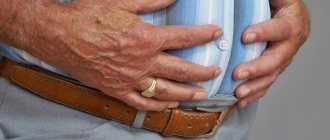Main symptoms:
- Painful bowel movements
- Lower abdominal pain
- Pain after bowel movement
- Headache
- Stool hardness
- Difficulty defecating
- A small amount of stool
- Loss of appetite
- Irritability
- Vomit
- Mucus in stool
- Nausea
- Fatigue
- Feeling of fullness in the stomach
Spastic constipation is a condition in which the act of defecation is disrupted. The spastic type of constipation occurs due to an imbalance of the nervous system and malfunctions of the gastrointestinal tract. Spastic constipation provokes a spasm that stops the bowel movement of processed food residues.
- Etiology
- Symptoms
- Diagnostics
- Treatment
- Prevention
The condition does not have a specific clinical picture. Diagnosis is carried out through laboratory and instrumental research methods. Treatment is prescribed on an individual basis.
What is spastic constipation?
Spastic constipation is called constipation, which occurs due to spasms of the intestinal muscles and is accompanied by bloating. Typically, stool with this type of constipation is fragmented, resembling goat feces. The absence of bowel movements is inconsistent, sometimes alternating with normal or even loose stools. Spastic constipation bothers a person for several days, after which bowel function returns to normal for a while.
A distinctive feature of this type of constipation is an increase in gas formation, the occurrence of spastic pain and a decrease in the patient’s performance. With a long course of the disease, a person notices increased fatigue and lethargy.
Symptoms of constipation and differences from other types
Spastic constipation differs from ordinary constipation in that fecal retention does not occur constantly, but only periodically, while between manifestations of constipation, a person’s stool can be absolutely normal, and sometimes slightly liquefied.
In some situations, after the onset of constipation, the patient may experience mild diarrhea, which is a kind of response of the body and intestines to the previous retention of feces and spasms of the intestinal muscles.
Most often, diarrhea is observed in cases where spastic constipation was caused by nervous strain or disorder.
The clinical picture of intestinal muscle spasm is in many ways similar to the condition of irritable bowel syndrome, so the symptoms of spastic constipation can be called :
- Presence of cramping abdominal pain;
- The release of lumps of mucus along with dense feces;
- Periodically occurring delay in bowel movement, which may be associated with certain situations;
- Increased irritability, excessive emotionality;
- Feeling of constant fatigue, fatigue;
- Feeling of intestinal fullness;
- Excessive gas production, leading to severe bloating and flatulence.
In some cases, the delay in bowel movement manifests itself to a slight extent, but feces are excreted in small quantities and only in small fragments, and after such a bowel movement a person remains with a feeling of heaviness in the abdomen and fullness of the intestines.
Causes
Constipation, which develops as a result of intestinal spasms, develops as a result of increased intestinal tone. In some areas, spasms form, which clamp the feces and lead to the loss of their ability to move through the intestines.
Often the spasm is accompanied by a feeling of heaviness and fullness in the abdomen, flatulence, and pain.
The main reasons for the development of spastic constipation are:
- hypothyroidism;
- diabetes;
- dysfunction of the ovaries;
- pathology of the pituitary gland;
- irritable bowel syndrome;
- neurogenic colitis;
- consequences of food poisoning;
- dysfunction of the autonomic nervous system.
Spastic constipation: signs and methods of treating pathology
Spastic constipation is a violation of bowel movements associated with a local increase in the tone of the colon. Circular contractions of smooth muscles predominate over longitudinal ones. Fecal masses have difficulty passing through narrow places in the digestive tract, so the frequency of bowel movements decreases.
Symptoms
- defecation is accompanied by straining and occurs less than 3 times a week;
- feeling of incomplete bowel movement after bowel movement;
- the stool is dense, in the form of rounded lumps or pencils;
- small amount of feces during bowel movements (less than 45 g);
- aching or cramping pain in the left half of the abdomen;
- a feeling of fullness, bloating in the abdomen, which decreases after the passage of gas and bowel movements;
- signs of intoxication: headaches, chronic fatigue, irritability, drowsiness, lack of appetite.
Constipation is considered chronic if its symptoms persist for at least 3 months in the last six months.
Do you have intestinal diseases? — Take the online test!
Causes
Pathology occurs when intestinal receptors are highly sensitive to irritants and there is a malfunction of the autonomic nervous system.
Leads to constipation:
- Eating disorders - snacking on the go, dry food, rare, irregular meals.
- Poor drinking regime . Liquid is intensively absorbed from the intestines. Feces become dry and dense, irritating the receptors of the colon. This leads to local spasms.
- Irritable bowel syndrome is a functional disorder that causes abdominal pain and bowel disorders, including constipation.
- Chronic colitis. The tone of the inflamed areas of the intestinal wall increases.
- Hypercalcemia . Calcium causes contractions of the smooth muscles of the digestive tract. Diseases in which the level of calcium in the blood increases: tumors of the parathyroid glands and pituitary gland, osteomyelitis, osteoporosis, multiple myeloma.
- Psychogenic factors . Stressful situations and depression provoke intestinal spasms.
- Dysbacteriosis. Intestinal microorganisms participate in the digestion of food and secrete substances that normalize peristalsis. When the composition of the microflora changes, the motor activity of the intestine is also disrupted.
- Smoking - nicotine increases smooth muscle tone and causes spasms of the colon.
Treatment
A set of therapeutic measures is aimed at normalizing peristalsis, combating increased gas formation and pain. It is important to establish and eliminate the cause of constipation: give recommendations on nutrition, lifestyle, treat concomitant diseases, and provide psychological assistance.
Diet
The goal of a diet for spastic constipation is to gently stimulate intestinal function without provoking spasms.
Dietary recommendations:
- Eat food in a calm environment, without rushing.
- Eat at least 4 times a day.
- Drink at least 2.2 liters of liquid daily: vegetable and fruit juices, weakly brewed tea, compotes, fruit drinks. Warm mineral water “Essentuki 4” reduces spasms of the colon.
- Include fermented milk products with live bifidobacteria and lactobacilli in your diet: yogurt, biokefir, acidophilus, yogurt.
- Eat boiled vegetables rich in fiber: beets, carrots. With spastic constipation, fresh fruits and vegetables can cause intestinal colic at the initial stage of treatment, so add them to the diet gradually.
- Avoid foods that increase gas formation: white cabbage, baked goods, legumes, grapes.
- Avoid products containing essential oils: radish, garlic, radish.
- Limit semolina porridge, potatoes, white bread - due to the small amount of ballast substances, they have a fixing effect.
Lifestyle correction
- "Toilet Training" .
Increased peristalsis in response to food intake is called the gastrointestinal reflex. With constipation, this mechanism is weakened or lost. To get it back, drink a glass of water in the morning half an hour before breakfast. Empty your bowels in a calm environment. Allow at least half an hour to go to the toilet. If there is no urge to defecate, use a glycerin suppository for the first days. - Fighting stress - if possible, avoid traumatic situations; in difficult cases, seek help from a psychologist.
- Quit smoking.
Medicines and dietary supplements
- Antispasmodics – reduce spasms of the intestinal wall and abdominal pain. The most effective drugs: Buscopan, No-spa, Dicetel. For lovers of natural remedies, herbal teas based on peppermint are suitable (see here).
- Carminatives - means to combat gas formation: Espumisan, Sab Simplex, dill water.
- Combined drugs . Meteospasmil contains two active components: simethicone, which reduces gas formation, and alverine citrate to relieve abdominal pain and cramps.
- Laxatives. For spastic constipation, doctors recommend osmotic agents to patients.
Preparations based on lactulose (Duphalac) and polyethylene glycol (Macrogol) slow down the absorption of water, soften the intestinal contents, and stimulate peristalsis. Medicines are not absorbed in the intestines and are not addictive.Irritating laxatives (Bisacodyl, senna extract), popular among the population, increase abdominal pain and bloating, so it is not advisable to take them for spastic constipation.
- Prebiotics are food additives containing ballast substances.
Prebiotics are not digested in the intestines, increase the volume of feces, stimulate peristalsis and the growth of physiological microflora. For spastic constipation, psyllium-based remedies are prescribed (Mukofalk, Psyllium, Fitomucil). Patients tolerate them better than wheat bran. - Probiotics.
Scientists have proven that preparations based on bifidobacteria (Bifiform, Bifidobacterin) reduce the time it takes for food to pass through the intestines by 12.4 hours. - Sedatives – if the pathology occurs due to stress, drugs that reduce emotional stress are prescribed: tablets or tincture of valerian, motherwort, peony, Novopassit.
Cleansing enema
For chronic constipation, use an enema in extreme cases, when other methods of cleansing the intestines do not help, and your health worsens. Consult your doctor first.
To perform an enema, buy an Esmarch mug at the pharmacy. This is a special rubber container to which a tube with a clamp is attached. The kit includes a set of tips: children's and adult. Before first use, rinse the product thoroughly with hot water and baking soda.
Procedure
- Prepare the place: cover the couch or bed with oilcloth on which you will give the enema. Lower the bottom edge of the oilcloth into a basin or bucket so as not to stain the laundry.
- Measure out 1.5 liters of clean filtered water, heat it to a temperature of 37ºC. Warm water relaxes the smooth muscles of the intestines and promotes the passage of stool.
- The patient lies on his left side so that the oilcloth is under the buttocks, and the right leg is slightly bent at the knee and hip joint. Due to the anatomical structure of the intestine, water moves better in this position.
- Fill the system: close the clamp on the tube, pour water into the rubber container. Hang it on a tripod or hook about 70cm above the couch. To allow air to escape from the tube, open the clamp and pour some water into the basin, then close the clamp again.
- Lubricate the tip with petroleum jelly or petroleum jelly and gently insert it into the anus with rotational movements up to the limiter.
- Open the clamp. According to the law of communicating vessels, the liquid will flow into the rectum. If, when administering an enema, the patient's stomach hurts, close the clamp and take a break for 1-2 minutes, continue if you feel better.
- To prevent air from entering the intestines, complete the procedure when there is some water left in the mug
Read more: Performing a cleansing enema using an Esmarch mug
Before going to the toilet, to stimulate bowel function, it is advisable to walk for 5-15 minutes, stroking your stomach.
Physiotherapy
There are physical exercises to improve the functioning of the digestive system. The physical therapy doctor develops an individual training program for each patient, taking into account age, general condition, and concomitant diseases.
Universal exercises:
- In the morning after waking up, stroke your stomach clockwise for 5 minutes.
- Before bowel movements, do abdominal thrusts: inhale and at the same time sharply draw in your stomach. Then exhale and inflate it. Repeat 8-10 times.
- Exercise “Bicycle”: lying on your back, make circular movements with your legs, imitating riding a bicycle. Repeat 20-25 times.
- Exercise "Scissors". Lie on your back with your arms extended along your torso. Raise your straight legs up at an angle of 45°, perform crossing movements. Repeat 10-15 times.
Symptoms
The main sign of spastic constipation is the absence of stool for 2-3 days or longer. Also, the development of the disease is indicated by the feeling of incomplete bowel movement after defecation. During bowel movements, feces are presented as a solid mass, which explains the pain and difficulty of leaving the intestines.
With spastic constipation, feces come out in small hard lumps, which are shaped like goat feces.
Clinical signs of spastic constipation include:
- feeling of abdominal distension;
- excessive gas formation;
- pain that resembles contractions in nature and is localized in various parts of the intestine;
- an admixture of mucus in the stool;
- feeling of nausea;
- headache;
- emotional disorders;
- decreased/lack of appetite.
Attacks of pain in a person suffering from spastic constipation intensify at the time of nervous shock and completely disappear during sleep.
Spastic constipation: causes, symptoms and diagnosis, treatment, prevention
Constipation is defined as bowel movement, associated with certain difficulties and accompanied by severe painful sensations. Experts divide such defecation difficulties into several types: atonic and spastic, functional and spasmodic. Spastic constipation is a consequence of impaired colonic function (hypokinesia).
Symptoms of spastic constipation
Constipation is considered a condition when there is no bowel movement for more than 48 hours. Many people mistakenly believe that bowel movements should occur every day, but this statement is incorrect.
Many people start taking laxatives if they have not had a bowel movement for one day. However, the frequency of bowel movements is individual for everyone; some people visit the bathroom once every 2-3 days, while others have bowel movements several times a day.
Signs of spastic type constipation are quite varied. These include:
- Hard and dense feces of a dry consistency, in the form of pellets, which is also called sheep feces, although sometimes spastic defecation difficulties are characterized by ribbon-like or cord-like feces;
- Defecation difficulties are accompanied by discomfort and pain in the intestinal area. When the gases pass, the patient usually experiences noticeable relief;
- Belching of air is often disturbing;
- If the patient manages to have a bowel movement, only a few lumps of feces are released;
- After bowel movement, patients do not have the usual feeling of relief;
- Due to the slow movement of feces, gases accumulate in the intestine, causing bloating and flatulence. Sometimes flatulence provokes severe pain in the myocardium;
- Patients with spastic constipation often lack appetite and have an unpleasant odor from the mouth;
- If constipation bothers you for several days, then intoxication symptoms appear, which are expressed in the form of headaches, fatigue and chronic fatigue, pallor and muscle pain.
As a result of such sensations, the patient becomes overly nervous and irritated, and some even become depressed and suffer from sleep disorders. But not all of the above symptoms are necessarily present in patients with constipation. If such defecation disorders occur quite often, then it is necessary to begin appropriate therapy.
Problems with defecation never appear out of nowhere, especially spastic ones. Intestinal spasm occurs due to an increase in the tone of the muscle tissue of the gastrointestinal tract. Experts call the main causes of spastic constipation:
- Increased intestinal gas formation;
- In women, spastic defecation difficulties may occur due to the onset of menopause, when ovarian activity is disrupted;
- Muscle spasm in a certain section of the intestine;
- Endocrine pathologies such as hypothyroidism, pituitary diseases or diabetes;
- In pregnant women in the last trimester;
- Irritable bowel syndrome;
- Frequent stress and depression can also trigger spastic constipation;
- Diet errors with constant or too frequent consumption of foods that irritate the intestines, such as fried meat or raw vegetables.
Sometimes spastic defecation difficulties develop against the background of intoxication with various toxins. To fix a problem, you need to know its root causes for sure. Therefore, you should contact an appropriate specialist to prescribe treatment.
Diagnostics
If you experience signs of spastic constipation, it is unacceptable to delay treatment; it is better to seek help from a specialist as soon as possible. The doctor will prescribe diagnostic procedures such as:
- Palpation of the abdominal area, during which a specialist can accurately assess the intensity of pain in different intestinal sections, detect spasmodic areas, etc.;
- Intestinal radiography, which reveals fecal compactions and visualizes damage to the intestinal walls;
- Laboratory examination of feces to determine microflora;
- Endoscopic diagnostics, during which it is possible to examine the mucous membranes of the lower structures of the gastrointestinal tract, assess their condition and identify damage;
- If there is a suspicion of an endocrine origin of constipation, the doctor will refer you for an individual consultation with an endocrinologist, who, if necessary, will prescribe additional diagnostic tests.
Diagnostics is extremely important in the treatment of spastic constipation, as it helps to accurately identify the etiology of defecation difficulties and select the most productive and effective therapy.
Therapy for spastic constipation is aimed at eliminating provoking factors and causes of the pathology. It is based on the use of medications, diet therapy and lifestyle correction.
- To eliminate spasms of the intestinal muscles, patients are prescribed antispasmodics, but only subject to strict adherence to dosages.
- Laxatives help empty your bowels.
- Correcting the diet is extremely important for normal digestion, which is why diet therapy is prescribed.
- If spastic constipation is of pathological origin, it is necessary to cure the disease that provoked the occurrence of spastic constipation.
Any drug should be taken only as prescribed by a doctor in accordance with the recommended dosages. Self-medication can only aggravate the condition, provoke complications or completely upset intestinal activity.
Enema
Sometimes, with spastic bowel movements, patients are prescribed cleansing enemas. The injected solution should have body temperature (about 36-38°C). You can do these enemas yourself at home. A solution of decoctions of mint and lemon balm is optimal for administration.
- Dry plant leaves are brewed and infused for about 20 minutes.
- Then the dishes with the infusion are placed on low heat and boiled for another half hour.
- The cooled broth is filtered and used for its intended purpose.
Such an enema solution will help in a short time to relieve spasms from the intestines and establish bowel movements. Oil solutions can also be used. But pure oil is prohibited.
You need to heat sea buckthorn, castor or olive oil, even ordinary sunflower oil and mix it with water, only then the solution is injected into the rectum.
Laxatives
It is strictly unacceptable to take laxatives without a doctor’s recommendation. Taking such drugs for spastic defecation difficulties is rarely used, because if the dosage is incorrect, they only intensify intestinal spasms.
If the patient systematically has intestinal problems, then he will have to stop taking laxatives.
Diet
Nutrition correction is a necessary condition for the treatment of spastic bowel movements. The main recommendations are that:
- It is necessary to exclude fatty, floury, fried and salty foods, meat soups, as well as astringent products such as red meat, rice, pomegranates, chocolates and strong tea;
- It is important to increase the consumption of vegetables and fruits, since they contain a large amount of dietary fiber necessary for normal gastrointestinal activity. Only plant products need to be pureed using a blender before eating;
- It is recommended to eat vegetable soups, have oatmeal with dried plums for breakfast;
- It is recommended to include low-fat fermented milk products such as kefir, whey or live yogurt in the diet;
- Instead of regular white bread, you need to eat whole grain or black bread.
Constipation in the elderly
The causes of constipation in older people are:
- neurological disorders;
- damage to the endocrine system;
- inactive lifestyle;
- errors in nutrition.
The vast majority of older people are prone to constipation, but treatment and diagnosis of the causes of the condition should be carried out exclusively by a specialist.
Treatment of constipation in this case should be carried out under the strict supervision of a doctor.
Constipation in children
Intestinal spasms in young patients often appear due to changes in diet, for example, when switching from natural to artificial feeding or introducing complementary foods.
In children over 12 months of age, spastic constipation may occur due to excessive consumption of sweets and small amounts of fluid intake.
Spastic type constipation can develop in a child as a result of emotional stress.
Treatment of children with spastic type of constipation is rarely carried out with the prescription of antispasmodic drugs. As a rule, in such cases, it is sufficient to use rectal suppositories, which have a relaxing and laxative effect.
Spastic constipation in childhood
In very young children, this pathological condition can develop for the following reasons:
- introduction of complementary foods;
- taking medications;
- transition to artificial nutrition;
- immaturity of the nervous system.
Children over 3 years of age may experience stabbing in the stomach after eating a large amount of confectionery or fast food.
Sometimes intestinal spasms can be a result of stress. Such pathological conditions are diagnosed in 30% of children.
The attending physician selects a therapeutic regimen based on the cause of the disease. Antispasmodics are prescribed extremely rarely. Most often, short-term use of laxatives and sedatives is sufficient to get rid of the problem.
Only a gastroenterologist should make an accurate diagnosis.
The following research methods are used for identification:
- sigmoidoscopy - endoscopic examination of the sigmoid colon, a thorough examination of the rectum with a special instrument;
- irrigoscopy - a diagnostic procedure, which is an X-ray of the intestine using a contrast agent;
- fibrocolonoscopy - examination of the mucous membranes of the large intestine.
The procedures described above allow us to assess the degree of peristalsis disturbance and the condition of intestinal tissues. In some cases, an analysis is carried out for dysbacteriosis, because due to a lack of lactic acid bacteria, rotting processes can occur that negatively affect both the digestive system and the entire body.
When palpating the abdominal region, pain appears in its various parts. A spasmodic sigmoid colon and a relaxed cecum are detected. How to treat spastic constipation?
Should you see a doctor?
Long-term constipation of any type can lead to various complications:
- secondary colitis;
- inflammation of the rectum;
- inflammation of the sigmoid colon;
- development of enteritis;
- development of pathologies of the biliary tract;
- hepatitis;
- hemorrhoids;
- anal fissures;
- paraproctitis, etc.
It is necessary to consult a specialist if bowel movement does not occur within 3 days.
If the patient begins to show signs of general intoxication of the body, as well as unbearable abdominal pain.
If constipation occurs in children, elderly or pregnant women, specialist advice should be sought as early as possible.
Diagnosis and treatment of constipation is carried out by a proctologist and gastroenterologist.
What food for spastic constipation
Spastic stagnation of feces occurs when, against the background of nervous experiences, frequent stress or neurological diseases, a contraction of a section of the intestine occurs with a narrowing of the general lumen of the gastrointestinal tract. In this place, the passage of food particles is disrupted, so stagnation occurs in adults and children.
There are products for eliminating stagnation of fecal stones:
- Fruits and vegetables, as well as nutrition based on fruits and vegetables;
- Whole grain baked goods;
- Bran;
- Buckwheat grain.
For constipation, diet 3 is recommended by doctors for patients with congestive changes in the gastrointestinal tract. If you consult a qualified specialist, after diagnosing the patient’s condition, the doctor will prescribe optimal nutrition.
Let us only add that daily fluid consumption should be at least 2 liters. If adults experience intestinal dysbiosis (disturbance in the relationship between pathogenic and saprophytic flora), it is rational to consume fermented milk products. A special diet for constipation (No. 3) is developed taking into account the calorie content and the body’s daily requirement for vitamin and mineral composition.
Treatment
Treatment of spastic constipation is complex. The main goal of therapy is to relieve intestinal spasms and cleanse the intestines of feces (a cleansing enema for spastic constipation is done in rare cases). Treatment is carried out under the supervision of a specialist and includes:
- taking medications;
- following a special diet;
- treatment with homeopathic remedies (in some cases);
- the use of therapeutic exercises.
Medication
As a rule, for spastic constipation, medications with antispasmodic effects are prescribed, which relax the intestinal muscles and restore its evacuation function.
Spastic constipation: symptoms, quick treatment, main causes
Constipation is difficult and painful bowel movement. Doctors distinguish several types of constipation: spastic, atonic, spasmodic, functional. All types are deviations from the normal functioning of the gastrointestinal tract. The difference is in the reasons for their appearance. For example, atony is a relaxed state of organs, and spasm is a tense state.
Spastic constipation ranks second among gastrointestinal disorders. Let's look at the causes, symptoms and methods of treating this disease.
Causes of constipation
A number of reasons disrupt intestinal functions. The consequence of improper bowel function is spastic constipation. The cause of spasticity is intestinal spasm.
The human intestine consists of muscles that contract to ensure the movement of food from the upper to the lower sections. Intestinal spasm is an involuntary contraction of muscles that causes cramping pain.
There are many diseases that can cause seizures:
- Acute gastritis.
- Stomach ulcer.
- Pancreatitis.
- Viral infections.
- Helminthiases.
- Tumor.
Spasm is one of the causes of tone disturbance. Tone is a state of nerve tissue in which fatigue does not occur. Hypertonicity is muscle overstrain, which causes the intestines to disrupt their own and other digestive organs (esophagus, stomach). Long-term muscle tension in adults can be caused by many factors:
- Neuroses, psycho-emotional disorders and stress lead to the body’s vital processes slowing down. The stomach does not digest food thoroughly enough. Food in an unprepared state enters the intestines, which find it difficult to push through undigested food residues.
- Increased consumption of high-calorie foods and lack of fiber in the diet.
- A sedentary lifestyle leads the body to loss of physical fitness. The activity of the muscles of the stomach, intestines, and digestive organs decreases.
- Dehydration causes stool to become dry and hard. The passage of feces through the intestines becomes difficult. Lack of water intake leads to intestinal dehydration. The intestines lose elasticity, which makes it difficult for feces to pass to the final section.
- Diabetes mellitus, obesity, and a number of infectious and gynecological diseases can cause muscle dysfunction.
Pregnant women often complain of difficult bowel movements. The longer a child is gestated, the more pressure the uterus puts on the colon and other digestive organs. The consequence of pressure is tension of neighboring organs
Children's spastic constipation is a consequence of changes in the intestinal nervous system. This happens, for example, when switching from breastfeeding to artificial formula.
The child's intestines are not ready to digest new types of foods. In older children, problems with eliminating waste may arise for psychological reasons.
Shocks such as going to kindergarten or school for the first time cause tension.
Complications
If you do not treat on time, complications begin, for example:
- Inflammation.
- Haemorrhoids.
- Rectal fissures.
- Colon cancer.
The first cause of complications is high temperature, as the body’s reaction to the onset of inflammatory processes.
To prevent complications from occurring, you need to start treatment on time. It is not recommended to self-medicate and start drinking laxatives. In some cases, taking stimulant medications leads to negative consequences.
To choose an effective treatment, you need to correctly identify the disease. Help in recognizing spastic constipation is knowing the main symptoms.
Symptoms of constipation
Spastic constipation is characterized by irregular defecation delays. During disruption of the colon, both normal bowel movements and loose stools are observed. To determine the type of stool retention, you need to know its signs.
It should be remembered that daily bowel movements are not necessary. A one-day absence of bowel movements is not a sign of tract obstruction. The main symptom of spastic constipation is regular cramping pain in the lower abdomen, predominantly of a spasmodic nature.
Other characteristic symptoms indicating spastic constipation include:
- Flatulence and bloating.
- Belching.
- Unpleasant taste in the mouth.
- Loss of appetite.
- Weakness of the body and rapid fatigue.
- Insomnia.
- Pallor of the skin, loss of elasticity.
Symptoms of childhood stool retention are specific. Babies scream in pain, cry, tuck their legs, behave capriciously and restlessly. Coprostasis is manifested by significant frequency of defecation for up to 36 hours, pain and colic in the abdomen, and tension during bowel movements. With constipation in infants, the stool becomes hard.
Pregnant women experience problems with bowel movements in the early stages. The main reason for difficult bowel movements is discomfort in the abdomen, a feeling of incomplete emptying of the intestines, and a quantitative decrease in stool. For many women, problems persist throughout pregnancy.
Treatment
When treating spastic constipation, the goal is to relieve spasm and free the intestines from stagnant fecal deposits. There are several ways to establish normal functioning of the digestive system. In order for the measures to be effective, it is necessary to carry out complex treatment.
Drug treatment
The doctor will help you choose an individual treatment for the patient by conducting the necessary examinations. The patient is examined by palpation. The doctor palpates the intestine, which in a state of spasm resembles a tight tourniquet.
Doctors recommend taking antispasmodics. Antispasmodics relieve pain by affecting the muscles of internal organs.
Anti-inflammatory substances relax the muscles and the pain goes away. These substances include metamizole sodium, pitofenone hydrochloride, fenpiverinium bromide.
Dibazol, Papaverine, No-Shpa, Papazol, Drotaverine are considered popular antispasmodic agents.
Sedatives cause calm and reduce emotional stress. As a sedative, doctors recommend herbal remedies: tinctures of valerian, motherwort or mint.
Some sleeping pills have a calming effect. Long-term use of sleeping pills instead of sedatives is not recommended. Well-known drugs that have a hypnotic effect include ankylosing spondylitis, Validol, Valocordin, Corvalol.
Non-drug treatment
Consultation with a doctor is necessary before any treatment, but in simple situations you can treat spastic constipation yourself.
You can get rid of spastic constipation at home using folk remedies. Herbs and seeds of some plants have a mild laxative effect.
It is recommended to take a teaspoon of infusion from dandelion roots three times a day to cleanse the intestines. Flax and plantain seeds are effective in combating spastic constipation.
It is important to wash down the eaten seeds with plenty of water. The swollen seeds stimulate the intestines to empty.
The second well-known method that will instantly cleanse the intestines is a cleansing enema. But this will not relieve stomach cramps.
For spastic constipation, the use of cold solutions is prohibited, since cooling the passageways will only worsen indigestion and increase cramping.
The liquid temperature should be 30-35 degrees. You can make an enema solution from mint or lemon balm leaves.
An enriched diet will help you quickly cope with stool retention. Products containing fiber improve stomach function. Eating fruits, vegetables, and berries will improve the process of food digestion.
Foods rich in sugars attract fluid into the intestines, which helps loosen the stool. Do not exclude jams, syrups, and honey from your diet.
Pickled, pickled vegetables, fermented milk products that contain organic acids help relieve spasms.
During bowel retention, avoid black coffee, chocolate, cheeses, pasta and alcohol.
Prevention
To prevent spastic constipation, follow simple rules. You should learn to avoid stress and distract yourself from current problems. Properly distribute meals during the working day. It is better to eat more often, but in small portions.
It is not recommended to eat 3 hours before bedtime. You need to drink at least 2 liters of water per day. Play sports, keep your body in good shape. A person who plays sports is in good physical shape. His risk of disease is reduced.
Take care of your health from a young age.
Source: https://GastroTract.ru/simptom/zapory/spasticheskij-zapor.html
Current forecast
In very rare cases, the disease leads to the formation of fecal stones, the development of intestinal obstruction, and fecal peritonitis. As a rule, elderly people and bedridden patients are susceptible to such complications.
If all doctor’s prescriptions are followed accurately and conscientiously, the prognosis is favorable.
Spastic constipation is an unpleasant and painful illness. Delayed treatment can lead to complications that threaten the health and life of the patient. However, timely consultation with a doctor and implementation of his recommendations can cure the patient of the pathology in a matter of days.










